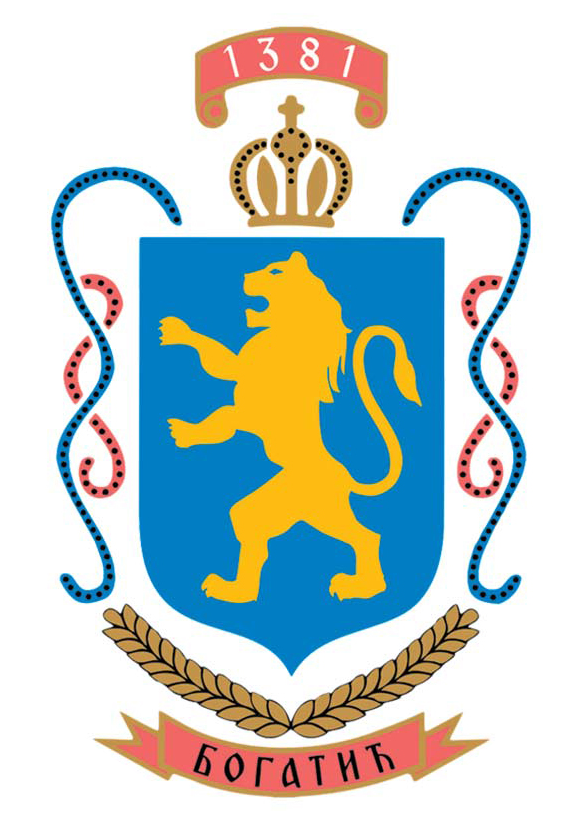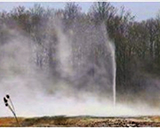Agriculture and infrastructure
The Mačva hydrogeothermal system was discovered in 1982. when a large conductive geothermal anomaly was discovered in the Neogene sediments in Dublje, i.e. in the central part of Mačva. At that time, hydrogeothermal research began, but it has not yet been completed. Their results show that the low-temperature convective hydrogeothermal system “Mačva” is part of a large regional same system, which extends below Mačva, Semberija and Srem on about 2000 km2. The results obtained so far are very interesting.
Beneath the Neogene sediments is a karst reservoir in Triassic limestones from which intensive exploitation of geothermal energy is possible for heating settlements, food production and for use in industry. Above the reservoir in the central part of Mačva, the most intense conductive geothermal anomaly in the entire Pannonian Basin was discovered, because thermal water with a temperature of 75C was discovered in a well at a depth of 412 m. That is why Mačva represents the Yugoslav and Serbian “Red Spot”, like the Pannonian Basin in Europe. The results of preliminary tests performed in exploratory wells, as well as the results obtained by hydrogeothermal modeling show that the exploitation of geothermal energy with a thermal power of at least 150 MW is possible in Bogatić, but its use has not yet begun.
Mića Martinović, Mihailo Milivojević
Faculty of Mining and Geology, Institute of Hydrogeology, Laboratory for Geothermal Energy
Introduction
Mačva is a large alluvial plain in Serbia between the Drina and Sava rivers, located about 80 km west of Belgrade. From a geotectonic point of view, Mačva is located on the southern edge of the Pannonian Basin, where it joins the Dinarides.
The Mačva hydrogeothermal system was discovered in 1982. when a large conductive geothermal anomaly was discovered in the Neogene sediments in Dublje, i.e. in the central part of Mačva (Milivojević et al., 1982). At that time, hydrogeothermal research began, but it has not yet been completed. Their results show that the low-temperature convective hydrogeothermal system “Mačva” is part of a large regional same system, which extends below Mačva, Semberija and Srem on about 2000 km2.
The results obtained so far are very interesting. Beneath the Neogene sediments is a karst reservoir in Triassic limestones from which intensive exploitation of geothermal energy is possible for heating settlements, food production and for use in industry. Above the reservoir in the central part of Mačva, the most intense conductive geothermal anomaly in the entire Pannonian basin was discovered, because thermal water with a temperature of 75oC was discovered in well BB-1 at a depth of 412 m (Milivojević et al., 1987). That is why Mačva represents the Yugoslav and Serbian “Red Spot” like the Pannonian Basin in Europe (Horvath, Bodri et al., 1979).
The results of preliminary tests performed in exploratory wells, as well as the results obtained by hydrogeothermal modeling show that the exploitation of geothermal energy with a thermal power of at least 150 MW is possible in Bogatić, but its use has not yet begun.
This paper presents the main characteristics of the Mačva hydrogeothermal system based on the results of previous research.
In preparation
The Directorate for Agriculture and the Village was established in 2006. year with the main goal of implementing agricultural development incentive programs. In this sense, the main tasks of the Directorate are:
1. Cooperation with the Ministry of Agriculture, scientific institutions, cooperatives and associations
2. Assistance to agricultural producers in the registration and re-registration of agricultural holdings
3. Assistance in the interpretation of laws and regulations in the field of agriculture, especially when exercising the right to state subsidies
4. Proposing measures and funds for the improvement of agricultural production as well as ways of distributing funds for incentives in agriculture
5. Work on the professional development of agricultural producers (organization of counseling, visits to fairs and exhibitions)
6. Monitoring the work of anti-hail protection on the territory of the municipality of Bogatić
7. Monitoring the condition and maintenance of agricultural facilities on the territory of the municipality of Bogatić
8. Monitoring the use of agricultural land
9. Establishment of own database of registered agricultural holdings in the municipality and production structure
The funds that the municipality’s budget will earmark for agricultural development incentives will first of all be used for placing short-term loans in agriculture without interest, for regressing interest on joint funds with banks, for the preventive prevention of soil and environmental pollution and for the education of agricultural producers through counseling and visits to fairs.
Planned expenditure of funds in 2009. years:
— For short-term lending of raw materials for spring sowing – 12.5 million dinars
— For regression of interest on joint funds with banks – 500 thousand dinars
— For non-reimbursed assistance in the procurement of nozzles and measuring cups for the training of sprinklers – 200 thousand dinars
— For the organization of counseling, presentation and going to fairs – 300 thousand dinars
— For the organization of the livestock fair – cattle exhibition – 400 thousand dinars
— The Directorate’s work program also plans activities in environmental protection, such as: pest control of households, cemeteries, garbage dumps and public facilities, as well as disinsection (dusting against mosquitoes).



